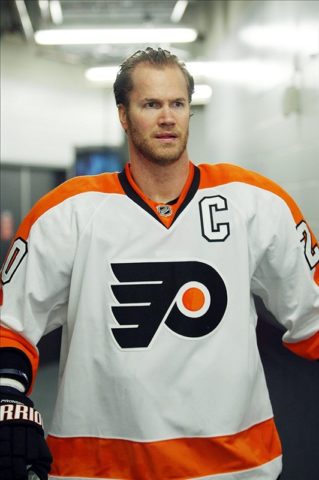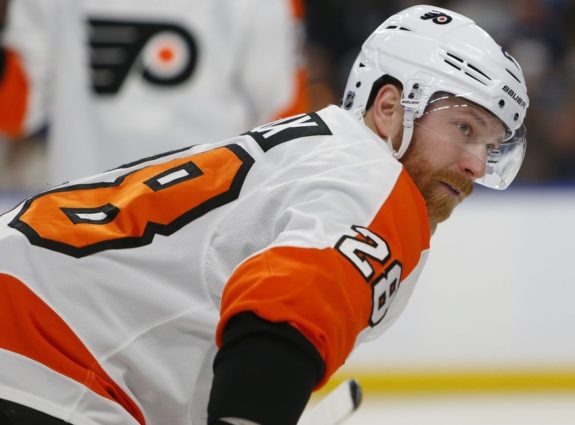The Philadelphia Flyers have said that acquiring a top-pair defenseman is their top priority this offseason, and general manager Chuck Fletcher has reportedly been in talks concerning just about every big name on the market since the regular season ended in early May. Reputable veteran defensemen Seth Jones and Dougie Hamilton seem to be the best fits, and the Flyers have enough capital to land Jones in a trade or Hamilton in a sign-and-trade or free agency.
Fletcher, who was hired by Philadelphia to replace former GM Ron Hextall in Nov. 2018, made a noteworthy splash in free agency in 2012 as GM of the Minnesota Wild, and his moves were in direct conflict with Paul Holmgren’s offseason plan, who was the Flyers’ GM at the time.
Flyers Outdone by Wild’s Fletcher
The Flyers made the postseason for the 16th time in 17 seasons in 2011-12. They defeated the Pittsburgh Penguins in the opening round in one of the most chaotic playoff series of all time but lost to the eventual Eastern Conference champion New Jersey Devils in the second round. The abrupt exit spurred an aggressive offseason. At that point, seven years into the salary cap era, Philadelphia was consistently among the biggest spenders in the NHL who constructed their rosters to compete for a Stanley Cup every year.

The Flyers’ 2012 offseason focused on the need for a top defenseman. Future Hall of Famer Chris Pronger had suffered a gruesome injury in Oct. 2011 and might never play in the NHL again. While defenseman Kimmo Timonen filled in as a solid power-play quarterback, the team needed to plug the gaping hole left by their captain on the top defensive pairing. They also traded former second-overall pick James van Riemsdyk to the Toronto Maple Leafs for defenseman Luke Schenn, a move that brought marginally useful depth to the blue line but created another hole, this time on the wing.
On July 4, Fletcher announced to the NHL that the Wild were entering a new era after three playoff appearances in their 12-year existence. He signed defenseman Ryan Suter and winger Zach Parise, arguably the top two free agents on the open market, to matching 13-year contracts worth an astounding $98 million apiece. The deals were front-loaded to include hefty signing bonuses early on to drive down the average annual value during the later years.
Holmgren was apparently outdone by Fletcher’s sudden shopping spree. Suter was rumored to be one of the Flyers’ main targets to solidify the hole on the blue line. Parise, a well-known hero for Team USA during the 2010 Olympics and a key contributor for the Devils during Philadelphia’s playoff loss, was a proven goal-scoring winger who would have complemented blossoming star, Claude Giroux, on the top line. The Flyers remained empty-handed after extending an offer sheet to restricted free agent Shea Weber that was matched by the Nashville Predators a few weeks later.
Organizational Directions – Flyers, Wild
The Flyers have won just one playoff series since their empty-handed offseason in 2012. In the next three seasons, four of their five highest draft picks were spent on defensemen. Sam Morin (11th in 2013), Robert Hagg (41st in 2013), Travis Sanheim (17th in 2014), and Ivan Provorov (7th in 2015) have had varying degrees of NHL success but have never filled the void left by Pronger and management has consistently struggled to surround Giroux with top-notch talent.

The Flyers are no longer considered a contender. Holmgren pushed the team into a difficult cap situation with ill-advised long-term commitments. After missing out on Parise, he signed 33-year-old forward Vincent Lecavalier to a five-year contract in July 2013, just days after he was bought out by the Tampa Bay Lightning. Holmgren further tried to patch the hole on defense at the 2014 trade deadline through the acquisition of Andrew MacDonald, who was quickly signed to a lucrative five-year deal that he never lived up to. Holmgren was replaced by Hextall in May 2014. The subsequent rebuild, a previously unfamiliar situation for the organization, took shape slowly, and a string of mediocre seasons led to the decision to bring in Fletcher.
Latest Flyers Content:
- Flyers News & Rumors: Sotheran, McDonald, Playoffs
- Philadelphia Flyers’ 2023-24 Team Awards
- Revisiting 3 Epic Flyers Playoff Clinches
- Flyers’ Ersson Finds His Groove Again in 1-0 Win vs. Devils
- Flyers’ Travis Konecny Hits 400 Career Points
Suter and Parise have been the Wild’s two best players since Fletcher signed them in 2012. Suter finished in the top 10 in Norris Trophy voting in each of his first five seasons in Minnesota, and Parise, despite a frustrating 2020-21 campaign, is the franchise’s leading point producer in the nine seasons he’s been with the club. Minnesota’s failure to become a true Stanley Cup contender lies in the fact that they’ve never fielded a truly complete roster that can compete with the NHL’s elite teams. Solid goaltending from Devan Dubnyk and contributions from Jason Zucker, Eric Staal, and Jared Spurgeon have resulted in just two playoff series wins since Parise and Suter were acquired.
Fletcher’s Time to Strike
Fletcher’s aggressive approach to the 2012 offseason should guide his plans for the Flyers in 2021. Parise and Suter signaled a step forward for the Wild, and the Flyers could use a similar infusion of talent after a disappointing 2020-21 season. Their successful core of veterans, like Giroux and center Sean Couturier, along with their developing young players, who mostly underperformed this season, is a more favorable organizational makeup than the one that Suter and Parise have been surrounded by in Minnesota.
Finding a bonafide top-pairing defenseman, like Jones (Columbus Blue Jackets) or Hamilton (Carolina Hurricanes), or even a gritty winger like Matthew Tkachuk (Calgary Flames), could help restore the franchise as one that consistently competes for the Stanley Cup. Like he did in July 2012, it’s time for Fletcher to act.